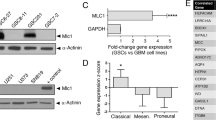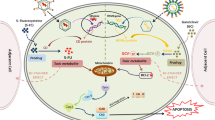Abstract
Glioblastoma is a very aggressive astrocytic tumor and most patients have 1-year survival time after diagnosis. A promising therapeutic strategy is the local delivery of the herpes simplex virus thymidine kinase gene in the tumor bed followed by ganciclovir treatment. The presence of functional gap junctions is highly relevant for the success of suicide gene therapy. Connexins are expressed in practically all tissues and form gap junctions that allow intercellular communication. Connexin 43 (Cx43) is the major connexin member being expressed in astrocytes but its status in glioblastoma is not well defined. We have investigated by immunofluorescence the presence of Cx43 in 74 human glioblastoma samples; its expression was detected in 77% of the samples analyzed. We report here that glioblastoma is a heterogenous disease as regards Cx43 expression with presentations, in which Cx43 expression is unaltered, reduced or totally lost. A predominant Cx43 cytoplasmic localization was observed in four out of eight primary glioblastoma cultures that we have established. This aberrant localization reduced gap junctionnal intercellular communication by 50 to 75% as compared with primary cell cultures displaying gap junctional plaques. However, the bystander effect evaluated after lentiviral delivery of the herpes simplex virus thymidine kinase gene and ganciclovir treatment was detected in all Cx43-positive primary cell cultures, and it was independant of the Cx43 localization. These findings may have important clinical implications for the design of anticancer cytotoxic therapies that rely on the gap junction-mediated bystander effect for their success.
This is a preview of subscription content, access via your institution
Access options
Subscribe to this journal
Receive 12 print issues and online access
$259.00 per year
only $21.58 per issue
Buy this article
- Purchase on Springer Link
- Instant access to full article PDF
Prices may be subject to local taxes which are calculated during checkout





Similar content being viewed by others
References
Laird DW . Life cycle of connexins in health and disease. Biochem J 2006; 394: 527–543.
Willecke K, Eiberger J, Degen J, Eckardt D, Romualdi A, Guldenagel M et al. Structural and functional diversity of connexin genes in the mouse and human genome. Biol Chem 2002; 383: 725–737.
Wilgenbus KK, Kirkpatrick CJ, Knuechel R, Willecke K, Traub O . Expression of Cx26, Cx32 and Cx43 gap junction proteins in normal and neoplastic human tissues. Int J Cancer 1992; 51: 522–529.
Zhang W, Couldwell WT, Simard MF, Song H, Lin JH, Nedergaard M . Direct gap junction communication between malignant glioma cells and astrocytes. Cancer Res 1999; 59: 1994–2003.
Lin JH, Takano T, Cotrina ML, Arcuino G, Kang J, Liu S et al. Connexin 43 enhances the adhesivity and mediates the invasion of malignant glioma cells. J Neurosci 2002; 22: 4302–4311.
Oliveira R, Christov C, Guillamo JS, Debouard S, Palfi S, Venance L et al. Contribution of gap junctional communication between tumor cells and astroglia to the invasion of the brain parenchyma by human glioblastomas. BMC Cell Biol 2005; 6: 7.
Ito A, Koma Y, Uchino K, Okada T, Ohbayashi C, Tsubota N et al. Increased expression of connexin 26 in the invasive component of lung squamous cell carcinoma: significant correlation with poor prognosis. Cancer Lett 2006; 234: 239–248.
Naoi Y, Miyoshi Y, Taguchi T, Kim SJ, Arai T, Maruyama N et al. Connexin26 expression is associated with aggressive phenotype in human papillary and follicular thyroid cancers. Cancer Lett 2008; 262: 248–256.
Naoi Y, Miyoshi Y, Taguchi T, Kim SJ, Arai T, Tamaki Y et al. Connexin26 expression is associated with lymphatic vessel invasion and poor prognosis in human breast cancer. Breast Cancer Res Treat 2007; 106: 11–17.
Huang RP, Hossain MZ, Sehgal A, Boynton AL . Reduced connexin43 expression in high-grade human brain glioma cells. J Surg Oncol 1999; 70: 21–24.
Aronica E, Gorter JA, Jansen GH, Leenstra S, Yankaya B, Troost D . Expression of connexin 43 and connexin 32 gap-junction proteins in epilepsy-associated brain tumors and in the perilesional epileptic cortex. Acta Neuropathol (Berl) 2001; 101: 449–459.
Soroceanu L, Manning Jr TJ, Sontheimer H . Reduced expression of connexin-43 and functional gap junction coupling in human gliomas. Glia 2001; 33: 107–117.
Pu P, Xia Z, Yu S, Huang Q . Altered expression of Cx43 in astrocytic tumors. Clin Neurol Neurosurg 2004; 107: 49–54.
Caltabiano R, Torrisi A, Condorelli D, Albanese V, Lanzafame S . High levels of connexin 43 mRNA in high grade astrocytomas. Study of 32 cases with in situ hybridization. Acta Histochem 2010; 112: 529–535.
Naus CC, Laird DW . Implications and challenges of connexin connections to cancer. Nat Rev Cancer 2010; 10: 435–441.
Adamson C, Kanu OO, Mehta AI, Di C, Lin N, Mattox AK et al. Glioblastoma multiforme: a review of where we have been and where we are going. Expert Opin Investig Drugs 2009; 18: 1061–1083.
Immonen A, Vapalahti M, Tyynela K, Hurskainen H, Sandmair A, Vanninen R et al. AdvHSV-tk gene therapy with intravenous ganciclovir improves survival in human malignant glioma: a randomised, controlled study. Mol Ther 2004; 10: 967–972.
Moolten FL . Tumor chemosensitivity conferred by inserted herpes thymidine kinase genes: paradigm for a prospective cancer control strategy. Cancer Res 1986; 46: 5276–5281.
Fick J, Barker II FG, Dazin P, Westphale EM, Beyer EC, Israel MA . The extent of heterocellular communication mediated by gap junctions is predictive of bystander tumor cytotoxicity in vitro. Proc Natl Acad Sci USA 1995; 92: 11071–11075.
Mesnil M, Piccoli C, Tiraby G, Willecke K, Yamasaki H . Bystander killing of cancer cells by herpes simplex virus thymidine kinase gene is mediated by connexins. Proc Natl Acad Sci USA 1996; 93: 1831–1835.
Dilber MS, Abedi MR, Christensson B, Bjorkstrand B, Kidder GM, Naus CC et al. Gap junctions promote the bystander effect of herpes simplex virus thymidine kinase in vivo. Cancer Res 1997; 57: 1523–1528.
Czyz J, Irmer U, Schulz G, Mindermann A, Hulser DF . Gap-junctional coupling measured by flow cytometry. Exp Cell Res 2000; 255: 40–46.
Cottin S, Ghani K, Caruso M . Bystander effect in glioblastoma cells with a predominant cytoplasmic localization of connexin43. Cancer Gene Ther 2008; 15: 823–831.
Dull T, Zufferey R, Kelly M, Mandel RJ, Nguyen M, Trono D et al. A third-generation lentivirus vector with a conditional packaging system. J Virol 1998; 72: 8463–8471.
Caron MC, Caruso M . A nuclear localization signal in the matrix of spleen necrosis virus (SNV) does not allow efficient gene transfer into quiescent cells with SNV-derived vectors. Virology 2005; 338: 292–296.
Naus CC, Bechberger JF, Caveney S, Wilson JX . Expression of gap junction genes in astrocytes and C6 glioma cells. Neurosci Lett 1991; 126: 33–36.
Cottin S, Ghani K, de Campos-Lima PO, Caruso M . Gemcitabine intercellular diffusion mediated by gap junctions: new implications for cancer therapy. Mol Cancer 2010; 9: 141.
Mesnil M, Crespin S, Avanzo JL, Zaidan-Dagli ML . Defective gap junctional intercellular communication in the carcinogenic process. Biochim Biophys Acta 2005; 1719: 125–145.
Shinoura N, Chen L, Wani MA, Kim YG, Larson JJ, Warnick RE et al. Protein and messenger RNA expression of connexin43 in astrocytomas: implications in brain tumor gene therapy. J Neurosurg 1996; 84: 839–845; discussion 846.
Estin D, Li M, Spray D, Wu JK . Connexins are expressed in primary brain tumors and enhance the bystander effect in gene therapy. Neurosurgery 1999; 44: 361–368; discussion 368–369.
Asklund T, Appelskog IB, Ammerpohl O, Langmoen IA, Dilber MS, Aints A et al. Gap junction-mediated bystander effect in primary cultures of human malignant gliomas with recombinant expression of the HSVtk gene. Exp Cell Res 2003; 284: 185–195.
Pepper MS, Montesano R, el Aoumari A, Gros D, Orci L, Meda P . Coupling and connexin 43 expression in microvascular and large vessel endothelial cells. Am J Physiol 1992; 262: C1246–C1257.
Liu Q, Nguyen DH, Dong Q, Shitaku P, Chung K, Liu OY et al. Molecular properties of CD133+ glioblastoma stem cells derived from treatment-refractory recurrent brain tumors. J Neurooncol 2009; 94: 1–19.
Rainov NG . A phase III clinical evaluation of herpes simplex virus type 1 thymidine kinase and ganciclovir gene therapy as an adjuvant to surgical resection and radiation in adults with previously untreated glioblastoma multiforme. Hum Gene Ther 2000; 11: 2389–2401.
Acknowledgements
We are grateful to Pedro Otavio de Campos-Lima for critical reading of the manuscript. This work was supported in part by Schering-Plough Canada.
Author information
Authors and Affiliations
Corresponding author
Ethics declarations
Competing interests
The authors declare no conflict of interest.
Rights and permissions
About this article
Cite this article
Cottin, S., Gould, P., Cantin, L. et al. Gap junctions in human glioblastomas: implications for suicide gene therapy. Cancer Gene Ther 18, 674–681 (2011). https://doi.org/10.1038/cgt.2011.38
Received:
Revised:
Accepted:
Published:
Issue Date:
DOI: https://doi.org/10.1038/cgt.2011.38
Keywords
This article is cited by
-
Connexin 43 confers chemoresistance through activating PI3K
Oncogenesis (2022)
-
Recent progress in the research of suicide gene therapy for malignant glioma
Neurosurgical Review (2021)
-
An armed, YB-1-dependent oncolytic adenovirus as a candidate for a combinatorial anti-glioma approach of virotherapy, suicide gene therapy and chemotherapeutic treatment
Cancer Gene Therapy (2015)
-
Connexins: junctional and non-junctional modulators of proliferation
Cell and Tissue Research (2015)



